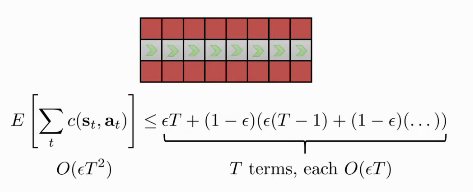Imitation Learning
Behavioural Cloning
Behavioural cloning is a fancy name for supervised learning. We
collect tuples of actions and observations from demonstrations, and
used supervised learning to learn a policy
The problem with behavioural cloning is that the errors accumulate,
and the state trajectory will change dramatically. When we evaluate
the algorithm, can we make
DAgger: Dataset Aggregation
- Goal: collect training data from
- how? run
- train
- run
- Ask human to label
- Aggregate:
- Problem: have to ask humans to label large datasets iteratively, and can be unnatural (resulting in bad labels)
- Behavioural cloning may still work when we model the expert very accurately (no distributional “drift”)
Why might we fail to fit the expert?
-
non-Markovian behaviour
- Our policy assumes that the action depends only on the current observation.
- Perhaps a better model is to account for all observations.
- Problem: history exacerbates causal confusion (Haan, Jayaraman, and Levine, n.d.)
-
Multimodal behaviour
- Solutions:
- output mixture of Gaussians (easy to implement, works well in practice)
- Latent Variable models (additional latent variable as part of input)
- Autoregressive discretization
- Solutions:

Figure 1: Autoregressive Discretization discretizes one dimension of the action space at a time
What’s the problem with imitation learning?
- Humans need to provide data, which is typically finite. Deep models typically require large amounts of data.
- Human are not good at providing some kinds of actions
- Humans can learn autonomously (from experience)
Imitation Learning in the RL context
Reward function:
Cost function:
The number of mistakes go up quadratically in the worst case:
Assuming:

Figure 2: The tightrope walking problem
Bibliography
Haan, Pim de, Dinesh Jayaraman, and Sergey Levine. n.d. “Causal Confusion in Imitation Learning.” http://arxiv.org/abs/1905.11979v2.